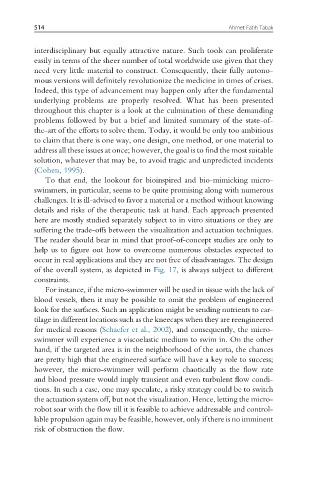Page 521 - Handbook of Biomechatronics
P. 521
514 Ahmet Fatih Tabak
interdisciplinary but equally attractive nature. Such tools can proliferate
easily in terms of the sheer number of total worldwide use given that they
need very little material to construct. Consequently, their fully autono-
mous versions will definitely revolutionize the medicine in times of crises.
Indeed, this type of advancement may happen only after the fundamental
underlying problems are properly resolved. What has been presented
throughout this chapter is a look at the culmination of these demanding
problems followed by but a brief and limited summary of the state-of-
the-art of the efforts to solve them. Today, it would be only too ambitious
to claim that there is one way, one design, one method, or one material to
address all these issues at once; however, the goal is to find the most suitable
solution, whatever that may be, to avoid tragic and unpredicted incidents
(Cohen, 1995).
To that end, the lookout for bioinspired and bio-mimicking micro-
swimmers, in particular, seems to be quite promising along with numerous
challenges. It is ill-advised to favor a material or a method without knowing
details and risks of the therapeutic task at hand. Each approach presented
here are mostly studied separately subject to in vitro situations or they are
suffering the trade-offs between the visualization and actuation techniques.
The reader should bear in mind that proof-of-concept studies are only to
help us to figure out how to overcome numerous obstacles expected to
occur in real applications and they are not free of disadvantages. The design
of the overall system, as depicted in Fig. 17, is always subject to different
constraints.
For instance, if the micro-swimmer will be used in tissue with the lack of
blood vessels, then it may be possible to omit the problem of engineered
look for the surfaces. Such an application might be sending nutrients to car-
tilage in different locations such as the kneecaps when they are reengineered
for medical reasons (Schaefer et al., 2002), and consequently, the micro-
swimmer will experience a viscoelastic medium to swim in. On the other
hand, if the targeted area is in the neighborhood of the aorta, the chances
are pretty high that the engineered surface will have a key role to success;
however, the micro-swimmer will perform chaotically as the flow rate
and blood pressure would imply transient and even turbulent flow condi-
tions. In such a case, one may speculate, a risky strategy could be to switch
the actuation system off, but not the visualization. Hence, letting the micro-
robot soar with the flow till it is feasible to achieve addressable and control-
lable propulsion again may be feasible, however, only if there is no imminent
risk of obstruction the flow.

